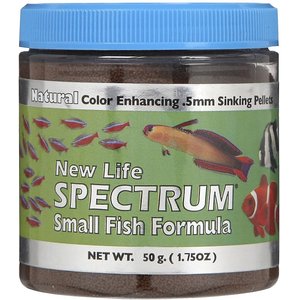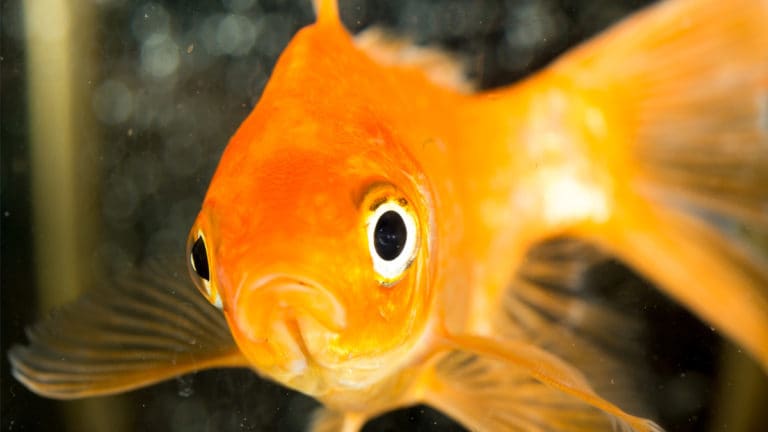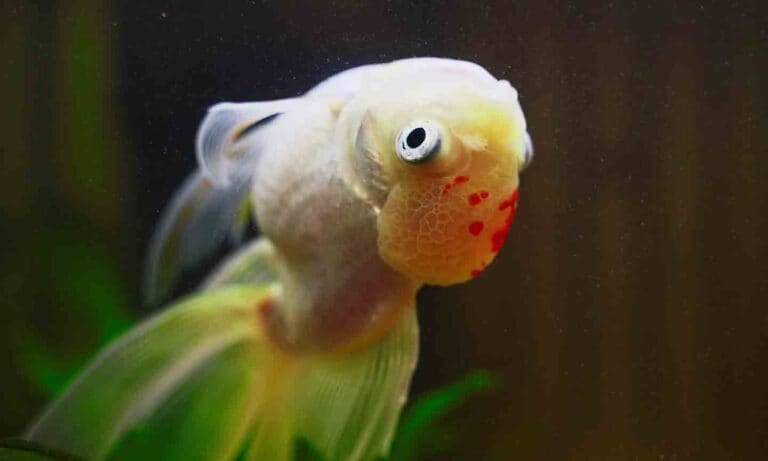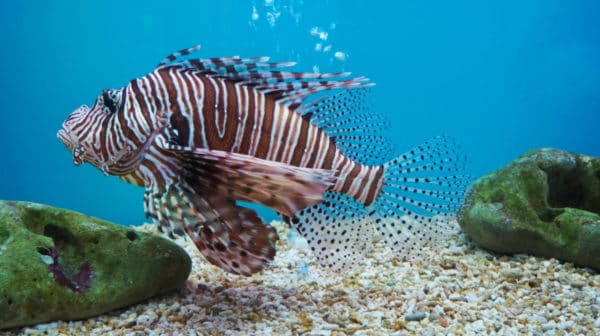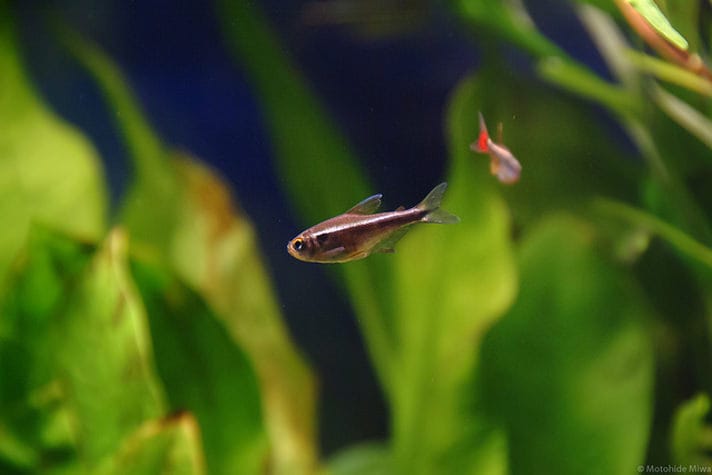Once fish eggs have hatched, you’ve only just begun the journey to breeding fish and raising their young. Keeping fry alive is far more difficult than getting their parents to breed, and after a successful mating this can be tedious and difficult.
For one thing, while most cichlid fish and livebearer fry are large enough to eat commercially prepared fish food at hatching time, most other fish, including rainbowfish, gouramies, gobies and tetras, require a smaller food source. In fact, the fry of these fish would barely be large enough to be a food source for cichlids and livebearers.
Also, many young fish will only eat food that is moving. You have a short period in which to adapt a young fish to nonmoving food before the fish will die. If you can keep it alive through this period, however, you typically can convert a fish to flake and other commercial foods when it gets older.
The following overview of many of the foods used by aquarists to feed their fry will help you keep your fry alive. Each of these foods provides enough nutrients that it could be used alone, but you should use several different foods when feeding your fry to help satiate their different appetites.
Prepared Foods
Prepared foods are not alive. Here, we will cover boiled egg yolk, powdered egg yolk, liquid fish food and commercial fry flake.
Boiled Egg Yolk
This is an easy, inexpensive food to use with young fry. It has the added bonus of not resulting in the unpleasant smells that live cultures often create.
To prepare this yolk food, start by hardboiling an egg. Remove the shell and egg white — all you need is the yolk. Place a small piece of the yolk in a small container with water (unused yolk can go into a sealed container in the refrigerator), and shake the container vigorously. When you agitate the water the yolk should dissolve, and you now have a suspended food that you can feed your fry.
If necessary, pass the mixture through a cloth to sift out any remaining larger pieces of yolk. You can then pour the egg yolk solution directly into the fish aquarium. It will typically remain suspended in the water for some time and will be eaten ravenously by most baby fish.
A single egg yolk could feed a batch of baby guppies for months. Of course, egg yolk won’t last that long in the fridge; discard any remaining yolk that begins to decompose. Also, do not add too much yolk to your mixture or add too much food to the aquarium, as it can cause pollution.
One problem with egg yolk is that some of the suspended yolk might be too big for the smallest fry to fit it into their mouths. Even after sifting, some pieces come out too large, so there may be less food to eat and more potentially water-fouling, uneatable food.
Powdered Egg Yolk
This is commonly available at pet stores, and you will find that powdered egg yolk is mixed with many other substances to help provide vitamins and minerals that can aid fish growth.
Powdered egg yolk can be added to an aquarium by sprinkling it directly on top of the water or mixing it with water before pouring it into the aquarium. Typically, if placed on the water surface, the food floats, whereas if you mix the food with water, it remains suspended for a short time before dropping to the bottom of the aquarium. Use both methods to maximize the opportunity for the fish to feed.
This food is excellent for small fish because it is much smaller than you could ever grind flake food. The actual size of powdered yolk is smaller than real suspended egg yolk, which can be very helpful when feeding the smallest of fry.
Liquid Fish Food
Liquid fish foods are foods that are already suspended in water. The particles tend to be too large for smaller fry to fit into their mouths, but there has been a shift toward smaller sizes. This new generation of liquid fry food has many hobbyists anxious for the final results. The initial results have been mixed, but these new liquid foods are small enough to be used in place of other small fry foods. Another plus for these is that they stay suspended long enough for small fish to eat them.
Commercial Fry Flake
Commercially available flake food for fry has been available for many years. Although fry flake foods are good for large fry, such as livebearers and most cichlid fish, they will not work well for small fry. The food is often as large as the fry themselves.
Cultured Foods
Live foods for fry include vinegar eels, microworms, baby brine shrimp and infusoria (both green water and zooplankton).
Vinegar Eels
Vinegar eels are a great food. They are easy to keep and very small (0.04 to 2 millimeters in length and 0.10 millimeter in diameter). Unlike microworms and other cultured foods, you can ignore your vinegar eel culture for weeks without killing off the culture.
A vinegar eel is actually not an eel — it is a nonparasitic roundworm, Turbatrix aceti, that can live in vinegar. Being a live food makes vinegar eels especially helpful in cases where fry will not accept prepared foods. Vinegar eels can live for a long time in aquarium water — often up to 24 hours — so they won’t pollute the aquarium water quickly and will provide a food that is available to your fry throughout the day.
Vinegar eels are so-called because they are cultured in apple cider vinegar. To prepare a culture, fill a quart or larger- sized jar half full of pure apple cider vinegar with no additives. Fill the remainder of the jar with water, preferably distilled or reverse osmosis water. Then add a couple of pinches of sugar or some apple slices, as this helps create food for the vinegar eels. After you’ve prepared your medium, add the eels to the mix.
Vinegar eel cultures are often available online and may be obtained through a local aquarium society. Let cultures grow about two weeks before harvesting.
It can be challenging to harvest vinegar eels.The vinegar that the eels live in is very acidic and can be deadly to fish, especially fry. Therefore, the eels must be removed from the vinegar. Given their small size, this can be tricky. You can purchase a small screen with holes small enough to allow the vinegar to pass through but not the eels, or you can try the long-neck bottle approach.
If you use the screen method, simply pour about half a cup of vinegar from your culture through the screen. You can then wash the vinegar eels off of the screen and into a cup to be dispersed among your fish aquariums. The long-neck bottle method involves using a bottle with a neck that is long and narrow. Fill the bottle with vinegar from the culture until it’s filled a little more than halfway up the bottle’s neck. Then put in a cotton ball, pushing it down until it is in the vinegar, but not submersed in it. Then add a little water above the cotton ball. The eels will move through the cotton into the water above, where they can be removed with a pipette or eye-dropper.
In either case, you will have a nontoxic food that is small and moving — and just great for newly developing fry. Because the vinegar eels are different sizes, there is likely to be a size for most every type of fry. However, it is likely that the smallest vinegar eels will not exist in sufficient quantity to act as your fry’s sole food source.
Infusoria: Zooplankton
Infusoria is not a single type of food; it is comprised of different types of organisms that are 0.02 millimeters and larger in diameter, depending on the species.
To create your own infusoria, place some hay, spinach or lettuce in a bottle of water, and put it in a sunny place. The problem with infusoria is that you have no control over what types of organisms are in the water, and some may be toxic to young fish. You could create a more usable infusoria by first boiling the hay, spinach or lettuce, and then introducing one of the paramecium species that is used as fish food. Aeration can be used to help decrease the decay and smell of the culture. For cultures intended to be kept beyond a few days, siphoning the bottom of the culture out every couple of days will help prolong the life of the culture.
Several paramecium species may be used, and the culture of different species has a good bit of variation. If you purchase or obtain a culture of paramecium, ask about any special directions for keeping that particular species. Many can be kept simply by covering the jar that contains your “salad” mixture and putting the jar in a sunny place.
Fill a 1-quart jar with water and your food source. Add the paramecium to the culture. You should be able to use the culture after about four days. Pour it through a piece of cloth to remove the wheat/hay/lettuce/spinach gunk. The water that has passed through the cloth should not be toxic to fish, and it and the organisms in it can be added to your aquarium.
Infusoria cultures do not last as long as vinegar eel cultures, so start a new culture every few weeks to ensure that you don’t run out of food. One of the biggest benefits of the paramecium is its extremely small size. It will produce a large amount of food at a very small size that will feed typically even the smallest of fry.
To avoid paramecium and other microscopic critters that are toxic or dangerous to fry, make sure you fully understand how to keep and feed your species before you begin feeding it to your fish.
Infusoria: Phytoplankton (Green Water)
Infusoria can be broken down into two categories. Zooplankton (discussed in the previous section) include microscopic living animals. Phytoplankton include microscopic plant material (0.02 to 2 millimeters in length). Aquarists speak of using green water as food, but they are actually referring to phytoplankton.
Green water is very easy to cultivate and extremely inexpensive. Simply take some water out of the aquarium (you should not need spinach, hay or lettuce for a culture if you use aquarium water), put it into a 1-quart jar, and place the jar in the sun. The sunlight will cause the water to turn green within a couple of days. When the water turns green, remove some and feed your fish. Then add some new aquarium water back to the culture to help maintain its longevity.
You’ll notice that this is very similar to how we cultured infusoria, and for good reason. Because they both contain microorganisms, we are relying on the replication of those for food. Any culture made from an aquarium will have both zooplankton and phytoplankton, but by increasing the direct sunlight by two to three hours, we encourage more phytoplankton to grow. On the other hand, if you keep the jar in an area that isn’t as well-lit, more zooplankton will grow.
Green water is among the smallest foods available, and many aquarists consider it indispensable when raising newly hatched fry that are too small to accept most other foods. Because the green water will float in the aquarium water, it can stay in the fish aquarium for a long time until it is consumed. One drawback is that the culture may suddenly collapse and need to be replaced. For this reason, it’s recommended to have multiple cultures “percolating” at the same time. It is also possible to order specific phytoplankton and grow them with more specific culturing and harvesting techniques.
Microworms
Microworms (Panagrellus redivivus) are small nematodes (0.05 to 2.0 millimeters long and 0.05 millimeter in diameter) that may seem initially too small for your baby fish (or too gross to touch). However, they have qualities that make them ideal candidates for growing fish.
To create a culture, mix about a tablespoon of corn meal with water until it forms a paste. Then add about a quarter-teaspoon of yeast. Place this mixture in the bottom of an empty peanut butter jar and add a culture of microworms. Screw on the lid, which should have holes punched into its middle. After a few days you’ll find that there are microworms crawling everywhere. Scrape them off the walls of the container with a razor blade or with your finger and feed them to your fish.
Fish eat these worms ravenously. Unlike vinegar eels, microworms will not live long in the water, so don’t overfeed. In addition to the microworms, the medium they live in may sometimes be introduced into the aquarium. If this happens, don’t worry; it, too, will be eaten by the fish and may provide another source of food for young fry.
Microworm cultures typically last about two weeks before they need to be replaced. You should not need to do anything to maintain this culture. As with green water, maintain two cultures at a time to avoid having any one culture crash.
Opinions vary on how to maximize a culture. Some people recommend using rolled oats instead of corn meal. Be aware that the smell of the culture is unpleasant. On the positive side, microworms are probably a better nutritional food for your fish than baby brine shrimp.
Baby Brine Shrimp
Newly hatched brine shrimp (0.08 to 0.12 millimeter) have been used in the hobby for years because of the ease of hatching and harvesting it. They are active in freshwater and can live in it for up to five days. There are many opinions on how to make the perfect brine shrimp hatchery. One way is to start with a 1-quart (or larger) jar of water and add about 2 teaspoons of sea salt per quart. Add about 17 ounces of brine shrimp eggs per quart, and aerate the water with a fish tank pump and some air line tubing. You may want to use an airstone, but be aware that doing so can cause problems if you use one that makes very fine bubbles. Ultra-fine bubbles can become lodged in newly hatched shrimp, causing them to float to the surface and suffer an untimely death.
Brine shrimp eggs hatch in 24 to 48 hours, after which the babies can be siphoned out and fed to your fish. Unplug the pump to stop the aeration, and allow the shrimp to settle to the bottom of the jar. Typically, hatched brine shrimp will congregate at or near the bottom of the water, and eggs will float. Use a piece of air line tubing to siphon the shrimp into a fine net or a cup (be careful not to siphon out any unhatched eggs). The little bit of saltwater you add to your aquarium while feeding brine shrimp is not a concern, but you can rinse the shrimp in freshwater if you wish.
It is discouraging to try to keep fry alive when they are so small and unable to eat what you can easily give them. But with a little work, you can create foods that will help get you through the difficulties of raising these small fish to adulthood.
Posted by: Chewy Editorial
Featured Image: Tony Terceira
Share:

